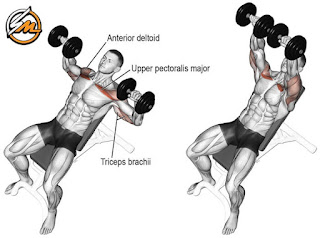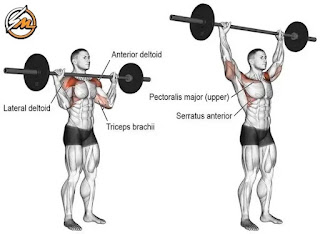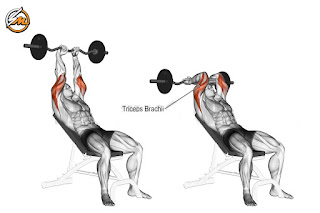Want to sculpt a rock-solid chest, build capped shoulders, and unleash herculean triceps? Look no further than the ultimate push workout! This program is designed to target all the major pushing muscle groups in your upper body, helping you achieve serious size and strength gains.
Ready to push your limits and build a physique that commands attention? Let's dive into this powerhouse workout!
Why Push Workouts Matter
Push workouts are a fundamental pillar of any upper body training routine. They target the muscles responsible for pushing movements, which are critical for everyday activities and athletic performance. Here's why push workouts deserve a prominent place in your training:
- Increased Upper Body Strength: Pushing exercises like bench presses, shoulder presses, and dips work a multitude of muscle groups, leading to significant gains in overall upper body strength. This translates to better performance in pushing exercises like push-ups and improved functional strength for everyday tasks.
- Enhanced Muscle Mass: Push workouts stimulate muscle growth in your chest, shoulders, and triceps. As these muscles grow larger, they contribute to a more defined and aesthetically pleasing upper body.
- Improved Posture: Strong push muscles help counteract the effects of tight pulling muscles in the back, leading to better posture and core stability. This can reduce back pain and improve overall well-being.
- Boosted Metabolism: Building muscle mass increases your resting metabolic rate, meaning your body burns more calories at rest. This can be beneficial for weight loss or maintenance.
The Push Workout Blueprint
This push workout incorporates a variety of exercises to target all aspects of your pushing muscles. It's designed with a progressive overload approach, meaning you'll gradually increase weight, sets, or reps over time to keep challenging your muscles and promoting growth.
Warm-Up (5-10 minutes):
- Light cardio (jumping jacks, jump rope, jogging)
- Dynamic stretches (arm circles, shoulder rolls, torso twists)
The Workout:
Best Push Day Workout Routine & Exercises for Muscle Growth
1- Cable Crossover
Cable crossover exercise is an excellent exercise to stretch your chest muscles, increase the range of motion and shred chest muscles.
The tension in the cable provides a softer and more continuous resistance than free weights that can be affected by momentum. Thanks to constant resistance, it triggers the work of many small stabilizing muscles in your chest in addition to the pectoral muscles.
Thanks to free work, you do not experience muscle imbalance, your muscles develop equally and you feel that you are experiencing pump at the end of the exercise.
Adjust the cable machine to the desired weight.
Stand with your feet shoulder-width apart and core engaged.
Grab the handles with palms facing forward and arms extended out to your sides, in line with your shoulders.
Maintaining a slight bend in your elbows throughout the exercise, slowly bring your arms together in a hugging motion across your chest. Imagine squeezing a large tree.
As you bring your arms together, allow them to slightly cross in front of your body at the peak of the contraction.
Focus on squeezing your chest muscles at the end of the movement.
Slowly reverse the motion back to the starting position with arms extended out to the sides.
2- Barbell Bench Press
The bench press is a popular strength training exercise that primarily targets the chest muscles (pectoralis major and minor). It is a fundamental exercise in bodybuilding, powerlifting, and general fitness training.
Overall, the bench press is an effective exercise for targeting multiple muscle groups in the upper body and can be a valuable addition to a strength training routine.
Lie flat on your back on a weight bench.
Grip the barbell with your hands slightly wider than shoulder-width apart. Your grip should be overhand, meaning your thumbs are wrapped around the bar.
Position the bar directly over your shoulders.
Arch your back slightly by pushing your shoulder blades together and squeezing your chest upwards. This will help to stabilize your spine.
Plant your feet firmly on the floor, hip-width apart.
Take a deep breath in and brace your core.
Lower the bar slowly and in a controlled manner towards your chest. Aim for the bar to touch around your lower pecs or nipple line.
Keep your elbows tucked in close to your body at about a 45-degree angle throughout the descent. Don't flare them out to the sides.
Once the bar touches your chest, exhale and press the weight back up to the starting position.
Focus on driving the weight with your chest muscles, not your shoulders.
3- Incline Dumbbell Press
The incline dumbbell press is a strength training exercise that targets the chest (upper pectoral) muscles, as well as the shoulders and triceps. It is performed on an incline bench set at a 30-45 degree angle, with a dumbbell in each hand.
Adjust the incline bench to your desired angle. A good starting point is 30-45 degrees, with a higher incline hitting the upper pecs more.
Pick up two dumbbells that challenge you but allow you to maintain good form throughout the reps.
Sit on the bench and lie back with the dumbbells resting on your thighs.
Hold the dumbbells with a neutral grip (palms facing each other) and position them directly above your shoulders with your arms bent at a 90-degree angle.
Squeeze your shoulder blades back and down, arch your lower back slightly to create core stability, and plant your feet flat on the floor hip-width apart.
Breathe in and initiate the movement by pressing the dumbbells straight up until your arms are nearly extended. Don't lock out your elbows completely.
Maintain a slight bend in your elbows throughout the movement to keep tension on your chest muscles.
Focus on squeezing your chest at the top of the movement when the dumbbells are almost touching.
Exhale as you slowly lower the dumbbells back down to the starting position, bringing them down in a controlled manner with your elbows tucked in close to your torso at about a 45-degree angle.
Don't let the dumbbells touch at the bottom. Stop just before they brush your chest to maintain tension in your muscles.
4- Standing Military Press
5- Dumbbell Side Raise
6- Incline Dumbbell Reverse Fly
7- Slight Incline EZ Bar Skull Crusher
8- Rope Pushdown
The rope pushdown is a variation of the triceps pushdown exercise that targets the triceps muscles using a rope attachment on a cable machine. This exercise offers a different grip and hand positioning, which can provide a unique stimulus for the triceps and contribute to overall arm strength and definition.
Here's how to perform it with proper form:
Attach a rope attachment to a cable machine at a high pulley setting.
Grasp the rope ends with palms facing down (overhand grip). You can adjust your hand position to be closer together or further apart depending on how you want to target different areas of your triceps. A narrower grip hits the outer tricep head more, while a wider grip emphasizes the inner triceps.
Stand tall with your feet shoulder-width apart and core engaged to stabilize your spine.
Position your upper arms by your sides, close to your torso, with your elbows bent at a 90-degree angle. The forearms should be pointing straight down towards the floor.
Breathe in and initiate the movement by pushing the rope down straight towards the floor. Focus on using your triceps to extend your elbows and straighten your arms, not using momentum or swinging your body.
Imagine you're squeezing your triceps to push the rope down. Don't completely lock out your elbows at the bottom, but keep a slight bend to maintain tension on the muscles.
Exhale as you slowly return the rope back up to the starting position with your elbows bent at 90 degrees. Control the movement and avoid letting the rope snap back up with force.
Cool-Down (5-10 minutes):
- Static stretches (chest stretch, shoulder stretch, tricep stretch)
Key Points for Push Workout Success:
- Focus on Form: Proper form is crucial for maximizing results and preventing injury. Don't sacrifice form for heavier weight.
- Mind-Muscle Connection: Concentrate on feeling the target muscles working throughout each exercise.
- Progressive Overload: Gradually increase weight, sets, or reps over time to keep challenging your muscles.
- Rest Periods: Allow sufficient rest between sets to recover and maintain intensity.
- Time Under Tension: Aim for controlled movements, focusing on the squeezing and contracting of the target muscles throughout the rep.
- Diet and Nutrition: Fuel your body with a balanced diet rich in protein to support muscle growth and recovery.
- Consistency: Stick to your workout program and prioritize consistency for long-term results.















0 Comments